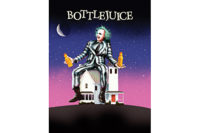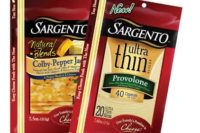
Berry Well
by Lori Dahm
Flavor trends weigh in on both sides of the spectrum: fruits versus indulgence.
The flavors of dairy products continue to exemplify a few specific trends — berry flavors that are ethnic in origin, indulgent and decadent flavors in frozen desserts and cup yogurts, and flavors that easily pair with functional and healthy dairy products. As always with flavors, consumers are more accepting of new flavors when they are couched in a taste or experience that seems familiar.
But whether the flavor being incorporated into a dairy
product is one of a tried-and-true nature or is bringing forward a new
trend, consumers continue to demonstrate predictable and reliable trends in
flavor preferences. Consumers enjoy decadence and indulgence fully within
dessert, but also seek an entirely separate experience with the newest
fruit flavors perceived as being complementary to healthy dairy products.
Berry a-go-go
Some of the flavor trends in berry flavors have
debuted in the smoothies, drinkable yogurts and cup yogurts that have
appeared in the new products over the past year. According to Productscan
Online, while strawberry, vanilla, peach and banana still rank in the top
four most popular new product introductions in 2006, raspberry and
blueberry were the next most popular flavors appearing in yogurt products.
“Drinkable yogurts have become hugely popular
and have helped to introduce more fruit flavor combinations to the dairy
industry, such as grapefruit, passion fruit and mango. Traditional flavors
such as strawberry still appear to dominate in these categories, but more
and more flavor combinations can be found in the dairy coolers, such as
strawberry-banana and peach-mango, reflecting growing interest in tropical
combinations,” says Dania Rosenthal, marketing specialist of the
natural products division at Mastertaste, Teterboro, N.J. “There has
been an increase in both ethnic and berry flavors appearing in the dairy
category. Many of these trends originated in Europe prior to their arrival
in the United States. Some common flavors in the ‘berry’
category include apricot, pear, cranberry and plum.”
This trend toward dark berry flavors is because
consumers perceive these as being healthier
— the dark red fruits have garnered a reputation for their
antioxidant content and corresponding health quotient — as well as a
carryover from the growing popularity of the ethnic cuisines to which these
fruits are inherent.
“Ethnic flavors and exotic flavors continue to
grow, especially Hispanic and tropical flavors such as coconut, horchata,
pineapple, mango and apricot,” says Peggy Pellichero, project leader
for dairy applications at David Michael Flavors, Philadelphia.
In fact, it is telling that while strawberry was the
most popular flavor in new milk and yogurt drinks in 1996, peach eclipsed
vanilla, and mango ranked in the top 10. Coconut almost made it to the top
ranks as well.
“Also, dark fruits like prune and plum are
showing up in newer products,” Pellichero says. “Not only do
they add to the health benefits of yogurt, but it is also a way of
attracting people at a young age to healthier foods.”
And the flavor of these yogurt products is expanding
to include concepts such as flax and whole grain being a yogurt component,
as well as the increasing acceptance of the flavor profiles of kefir and
the fermented dairy products that are more popular in Europe. As probiotics
and other healthy ingredients are making their way into dairy products, new
yogurts on the market continue to bring consumers taste experiences that
are new to them and meanwhile underscore their healthy positioning.
“We see innovation in many of the flavors for
smoothies. Popular fruit flavors such as pomegranate, berry and mango are
common in smoothies,” says Patty Baxendale, marketing manager at
Givaudan Flavors, Bridgeton, Mo. “We’re also beginning to see
smoothies with more exotic fruit flavors such as acai and goji berry. And
several fruit flavors that recently gained popularity due to their health
and wellness benefits are also showing up in ice cream — flavors such
as blueberry and pomegranate in particular.”
Indulge in Health
Speaking of ice cream, while the triumvirate of
vanilla, chocolate and strawberry will always reign supreme in the ice
cream world, it is interesting to note that new flavor trends are including
dark fruits as a transference from the healthy dairy halo. In fact, some
predict a return to frozen yogurt for health reasons.
“This year the biggest news was the launch of
packaged ice cream and novelties that were light products providing the
flavor, texture and creamy mouthfeel of their full-fat counterparts,”
says Karen Cycholl, senior marketing manager at Kerry Ingredients –
Kerry Sweet Ingredients, New Century, Kan. “Most leading brands now
market products in this category, which has raised consumers’
expectations of what a light product should deliver in taste and
quality.”
The technology or ingredients used to create these
lowfat ice cream products are by now well known, but some manufacturers are
still developing new and innovative means of playing in this lowfat market.
For example, David Michael is experimenting with using
naturally lowfat crème fraiche in ice cream. Crème fraiche
ice cream is prepared by combining cream with buttermilk in place of
standard cream in the base mix. The cultured cream imparts a smooth
texture, enhancing mouthfeel and creaminess and providing the illusion that
the product is higher in fat than its 5 percent.
“Thirty percent real fruit in a crème
fraiche base yields an amazing, velvety-smooth frozen confection that is
all natural, wholesome and lower in fat than traditional ice creams. And it
meets the standard of identity for a light ice cream,” says Marie
Cummings, manager of food applications and product development at David
Michael.
However, despite the movement toward lower fat in ice
cream, it is also worth noting that the flavors of fudge, caramel and
peanut butter still ranked in the top 10 most popular flavors in new ice
cream and frozen dessert products in 2006, according to Productscan Online.
“Indulgence continues to be the primary driver in
ice cream. Indulgent flavors such as cheesecake and brownie have shown
steady growth in recent years,” Baxendale says. “However,
ethnically influenced ice cream flavors are becoming popular. Our customers
are becoming more interested in ethnic flavors with mainstream appeal such
as mango and fried ice cream.”
One way that consumers are embracing indulgence in ice
creams is through inclusions; the newly popular fried ice cream variations
often include delightful chunks of fried dough or batter inside the ice
cream mix.
According to research conducted by the Kerry Group,
consumers fall into one of two groups: “purists” who like the
classics such as vanilla, chocolate or strawberry, versus the
“enthusiasts” who like ice cream loaded with chewy, chunky or
gooey pieces.
“The ‘enthusiasts’ make up almost 50
percent of the market, and the ice cream industry has responded in kind,
with indulgent flavors that mimic desserts. Peanut butter cheesecake,
turtle pieces and fried ice cream are growing in popularity,” Cycholl
says. “Baked inclusions show growth, with flavors like sticky bun and
toffee cake doing well in the market. Candy inclusions are strong, and some
of the more adventurous products include unique twists on classic
inclusions like chocolate and pomegranate combinations or European-style
biscuits mixed with tea varietals like white tea and green tea.”
The growing innovation in inclusion ingredients has
led to more indulgent inclusion pieces as well as some new developments,
such as the trend in single origin chocolates being translated into
inclusion varieties. As well, trends include regional flavors and authentic
ethnic inclusions and flavors.
“Futuristic flavor trends include more ethnic
flavors, especially Asian. Flavors such as sesame might soon debut, and
sesame makes a great peanut flavor replacer,” says Erin
O’Donnell, marketing manager at David Michael Flavors. “Green
tea, red bean and white tea can appeal to both Asian American and
mainstream palates. And red tea is a flavor that is truly excellent in ice
cream.”
Some of the continuing trends in the ice cream aisle
are the limited edition flavors.
“Especially around holiday time, manufacturers
introduce ice creams flavors with seasonal spices, such as ginger and
pumpkin,” Rosenthal says.
In fact, many predict that the “aroma”
flavors such as rose and lavender are the next big innovation destined for
the ice cream aisle.
“Although it hasn’t quite trickled down to
the mainstream supermarket levels yet, we think that spices, herbal and
floral flavors have a great deal of promise in the dairy category –
especially in ice cream,” O’Donnell says. “Look for other
new developments like chipotle or wasabi in dairy products. A few companies
have already launched ‘hot’ flavors in their products, such as
red-hot cinnamon and chili pepper.”
And what is a remarkable and unifying trend is that
with all of the indulgent flavor trends and new inclusion ingredients in
ice cream, the overriding health focus seems to reign supreme.
“Consumers are seeking products that are both
indulgent and healthy,” Pellichero says. “Calorie control is a
hot button, especially for children. For those products that are simply
indulgent, portion control may be necessary.”
Experts emphasize the need to create dairy products
that offer the ultimate health positioning to consumers.
“There is tremendous opportunity for innovation
in the dairy industry, and flavored milk in particular,” Baxendale
says. “Consumers already understand the health benefits of milk. By
adding more indulgent flavors, possibly with non-nutritive sweeteners and
UHT packaging, dairies can give consumers more of what they want.”
$OMN_arttitle="Berry Well";?>
